A little history
During the late Eighties, Mazda decided to launch several new brands reserved for the domestic market. Autozam, which specialized mostly in kei cars, these ultra-small Japanese vehicles promoted by the local tax system, was one of them. Production started in 1990.
In September 1992, the spectacular AZ-1 coupe hit the market. Developed from a Suzuki prototype, it featured a mid-engine layout and gullwing doors – possibly the smallest sportscar ever to receive such a device. A 657 cc engine taken from the Mazda Carol powered the AZ-1. Fitted with a turbocharger, this small three-cylinder was rated at 64 hp, which was adequate for such a light car. Suzuki would handle the production, and sell an AZ-1 sister as the Suzuki Cara.
The pre-production tests that Mazda carried out showed a rather high level of interest from the Japanese public. Sadly, the odds were against the AZ-1. By the time the car was dispatched to the dealerships two serious competitors had seen light: another Suzuki vehicle, the Cappuccino, and the even more threatening Beat sold by Honda. Worse: the AZ-1’s price had been set way too high, at a time when Japan was enduring a recession. As a result the AZ-1 simply didn’t sell, and was phased out after 1994. Slightly more than 4,000 had been built, to which should be added 500 Suzuki Cara.
About the models
Model: Autozam AZ-1
Year: c.1992
Maker: Hotworks
Scale: 1/43
Distributed by: Hotworks
Acquired: brand new, in December 2006, in Hong Kong, S.A.R.
The AZ-1 was only sold in two colours, Classic Red and Siberian Blue, and I was lucky enough to find them both. Apparently Hotworks ended up with the same problem Mazda had with the real thing, and seemingly got rid of the very last pieces seating in its warehouse for a very kind price. These die-casts seem somewhat light in hand, but there’s nothing surprising for such small models with large roofs made of transparent plastic. They are as beautiful as you could hope for, with all details perfectly reproduced, though the wiper is moulded with the windshield. Unfortunately metal and plastic sections of the body could have been better adjusted together. I’d give a 13/20 to both these models.
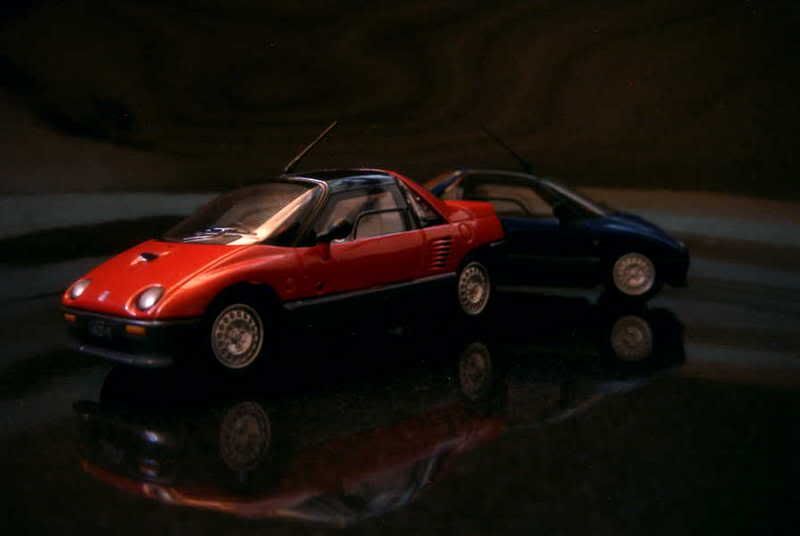
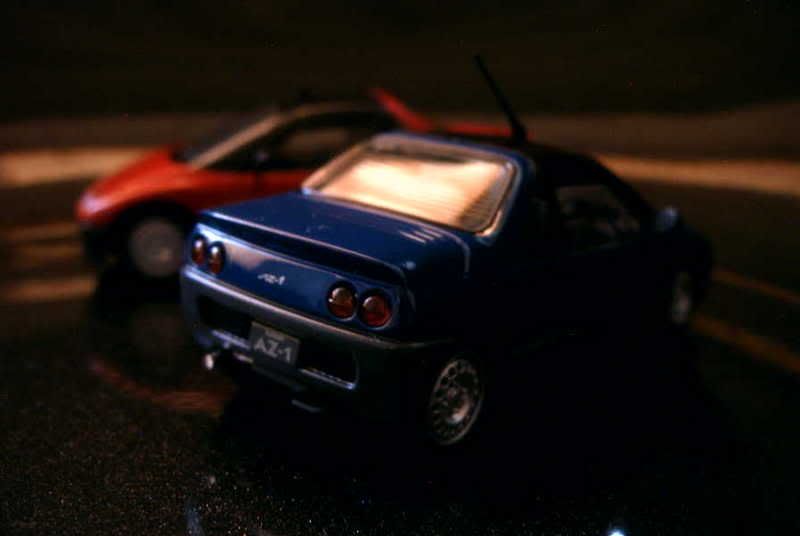
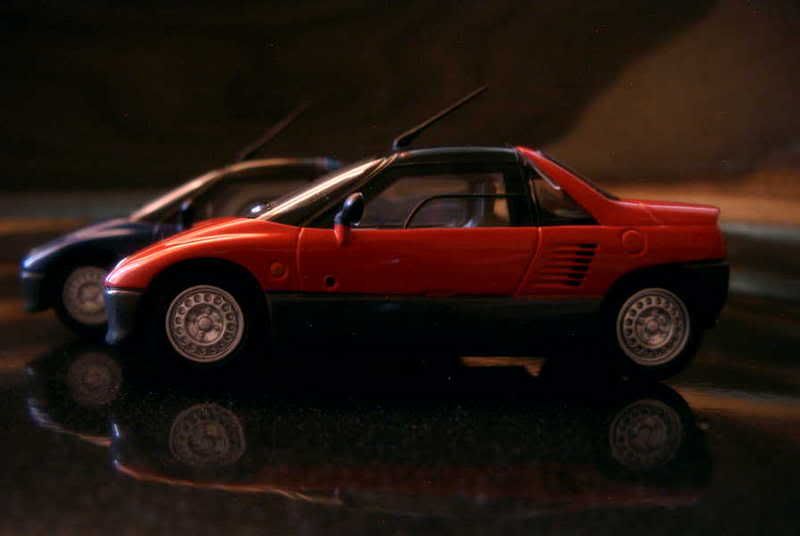
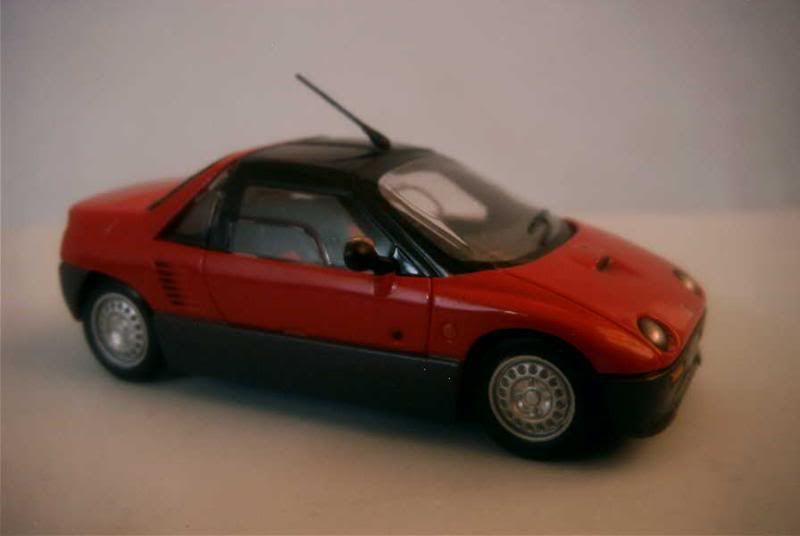
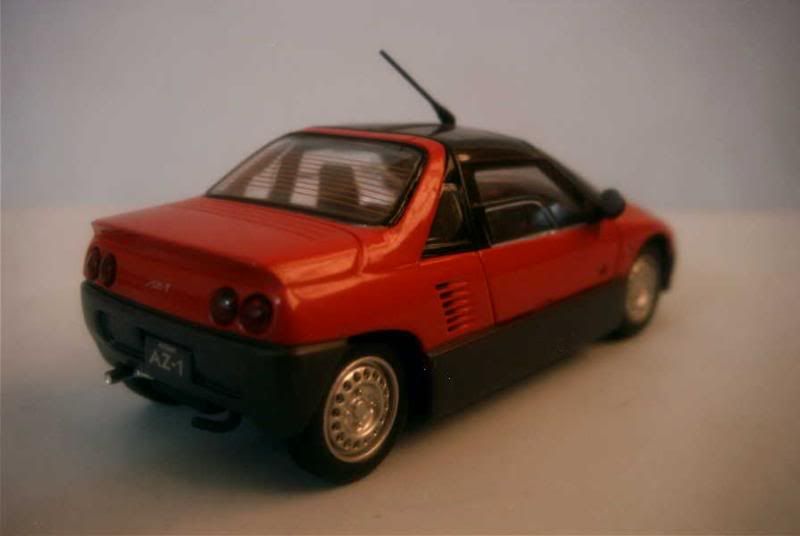
During the late Eighties, Mazda decided to launch several new brands reserved for the domestic market. Autozam, which specialized mostly in kei cars, these ultra-small Japanese vehicles promoted by the local tax system, was one of them. Production started in 1990.
In September 1992, the spectacular AZ-1 coupe hit the market. Developed from a Suzuki prototype, it featured a mid-engine layout and gullwing doors – possibly the smallest sportscar ever to receive such a device. A 657 cc engine taken from the Mazda Carol powered the AZ-1. Fitted with a turbocharger, this small three-cylinder was rated at 64 hp, which was adequate for such a light car. Suzuki would handle the production, and sell an AZ-1 sister as the Suzuki Cara.
The pre-production tests that Mazda carried out showed a rather high level of interest from the Japanese public. Sadly, the odds were against the AZ-1. By the time the car was dispatched to the dealerships two serious competitors had seen light: another Suzuki vehicle, the Cappuccino, and the even more threatening Beat sold by Honda. Worse: the AZ-1’s price had been set way too high, at a time when Japan was enduring a recession. As a result the AZ-1 simply didn’t sell, and was phased out after 1994. Slightly more than 4,000 had been built, to which should be added 500 Suzuki Cara.
About the models
Model: Autozam AZ-1
Year: c.1992
Maker: Hotworks
Scale: 1/43
Distributed by: Hotworks
Acquired: brand new, in December 2006, in Hong Kong, S.A.R.
The AZ-1 was only sold in two colours, Classic Red and Siberian Blue, and I was lucky enough to find them both. Apparently Hotworks ended up with the same problem Mazda had with the real thing, and seemingly got rid of the very last pieces seating in its warehouse for a very kind price. These die-casts seem somewhat light in hand, but there’s nothing surprising for such small models with large roofs made of transparent plastic. They are as beautiful as you could hope for, with all details perfectly reproduced, though the wiper is moulded with the windshield. Unfortunately metal and plastic sections of the body could have been better adjusted together. I’d give a 13/20 to both these models.








No comments:
Post a Comment